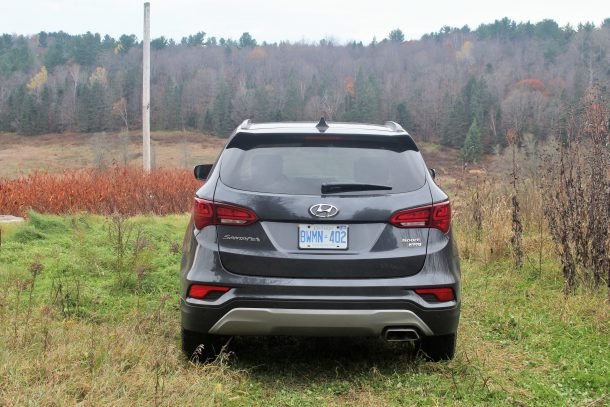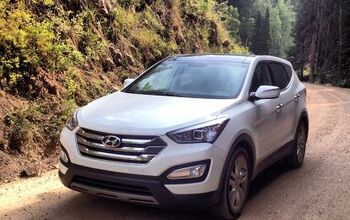2017 Hyundai Santa Fe Sport 2.4 AWD Review - Stakeout Special

2017 Hyundai Santa Fe Sport 2.4 AWD
A friend once asked me — jokingly, mind you — what vehicle would be the ride least likely to arouse suspicion from the police. The anti-heat score, if you will. As a proud (multiple) past owner, I knew the correct answer — a grey, ubiquitous, anonymous five- to 10-year-old General Motors sedan. At least, I thought I did.
Well, I take it all back.
Only while driving a Hyundai Santa Fe Sport does one realize that everyone else drives a Hyundai Santa Fe Sport. Everyone. In fact, you’re probably reading this in a Hyundai Santa Fe Sport. Allegedly, Hyundai sells the popular crossover in splashy colors like red, but a shade reminiscent of the slate-grey November sky that murdered the Edmund Fitzgerald’s crew seems to be the go-to choice for most buyers. Would-be bank robbers, scofflaws and undercover cops, take note.
If you’re one of the few who hasn’t yet signed on the dotted line for the Big Blue H’s lower-midsize crossover — newly refreshed for 2017, in case you weren’t aware — I drove one so you won’t have to.
Now, why does my mind keep returning to the ocean?
Disclaimer: Before you read this review, you need to know something about how Hyundai operates and packages its vehicles in North America. The Canadian and American marketing divisions of Hyundai are wholly independent of one another. Thus, the Santa Fe Sport reviewed here is very different in packaging from any Santa Fe Sport you can buy in the United States. In our quest to include all tested equipment in our U.S. pricing above, the numbers may not make sense on the surface. However, the American vehicle quoted includes a lot more additional equipment than that of the tested vehicle configured for the Canadian market.
Filling the gap
Slotted below its bigger, three-row brother and above the compact Tucson, the Santa Fe Sport straddles the line between compact and midsize — really, it’s a Santa Fe hacked to a more palatable size and price point. Call it the Studebaker Lark of crossovers.
For 2017, Hyundai’s gap-filler went into the shop for a mid-cycle makeover and came out looking, well, a lot like a 2016 Santa Fe Sport. So subtle are the redesigned front fascia, bumpers and taillights, you’ll probably need a “before” picture to squint at before the changes become clear. (LED running light “eyebrows” over the foglights are a dead giveaway.) The nip and tuck pushes the model’s appearance in the direction of the handsome Tucson, but not by much.
This tester boasted an entry-level powertrain that’s adequate for most purposes (and thrilling for none), upgraded “SE” trim, and all-wheel drive for those times when a snowstorm threatens to kibosh your attendance at a niece’s birthday party. It’s the Santa Fe Sport you’re most likely to stumble across in a parking lot.
Now for the bad news: that direct-injected 2.4-liter four-cylinder makes 185 horsepower and 178 lb-ft of torque — great numbers for a compact sedan, but decidedly less so for a 3,900-pound crossover. This allows Santa Fe Sport drivers to remain even more incognito to the long arm of the law.
Moving up to the turbocharged, 240 hp 2.0-liter four and lower aspect ratio tires found in uplevel models might make the “Sport” moniker seem like something less than a joke. In 2.4-liter guise, however, it’s a humorous misnomer. There’s no escaping the reality that this is a crossover, and a very mainstream one at that. No potential buyer expects to hang the tail out in corners on the way to Montessori, but the act of driving this vehicle and experiencing its reaction to human inputs quickly lulls anyone behind the wheel into a muted, emotional purgatory. It’s like sitting in a passenger ferry’s lounge with the heater cranked and the sun, low on the horizon, beaming in.
Perhaps ether emanates from those dashboard vents?
Big softie
Now, keep in mind, this isn’t an uncomfortable ferry — in fact, it’s damn nice place to sit. There’s not a single seating gripe to be heard from this perpetually uncomfortable 6-foot-4 driver. Excellent support and ample front legroom, plus armrests that put the Toyota RAV4 SE‘s to shame. Hyundai’s climate and infotainment controls are General Motors-level easy, so there’s nothing to raise your pulse in a bad way, either.
I could quibble about the slight encroachment into scalp territory of the rear seat headliner, but that’s only because of the panoramic sunroof — an upscale touch that makes owners and occupants alike feel special, and above all, successful. Rear-seat legroom could be improved, though the longer-wheelbase Santa Fe stands ready as a potential knee savior. Overall, fit and finish in this leather-trimmed cabin ranks high in perceived quality, and Hyundai should feel good about that. Just don’t bring a Venti coffee into this rig — the front seat cupholders have as much depth as a campus protester. You’ll be sorry.
It’s too bad about the puny 5-inch touchscreen staring from the center of an otherwise modern dash, but climbing another rung up the trim ladder delivers an 8-inch unit. You’ll also find a doubling of stereo speakers (12) and a push-button ignition, among other niceties. Safety aids like a Blind Spot Detection System, Lane Change Assist and Rear Cross-Traffic Alert appear on all but the lowest trim level.
On the road, the Santa Fe Sport’s entry-level Infinity audio system is robust enough to drown out the intermittent knocks and rattles that emanate from the rear of the cabin when the pavement turns to shell holes. With legs tuned for a soft, relaxing drive, throwing the worst at this particular model reveals its weak knees. Contrast that with the RAV4 SE’s springboard-stiff suspension, which, while bouncy, kept the shock of asphalt crevasses further from my backside when driving through regions that value cheap daycare over road repair.
In corners, though, I’d happily swap the two. The RAV4 SE’s ultra-firm suspension was unnerving in corners and only enhanced the sensation of top-heaviness. When driving a utility vehicle, I’d prefer to let good ol’ fashioned car-like front-end plow and body lean communicate the limits of traction, and not a bowel-loosening feeling of impending upset in a vehicle that would sooner turn turtle than compress a spring. For this, the Santa Fe Sport delivers.
(Note: Exactly zero Santa Fe Sport buyers are concerned with such things.)
We (don’t) got the power
Recognizing this model’s fate as a mild-mannered carrier of kids, the only real letdown is its drivetrain. Hyundai claims both available engines saw efficiency-minded enhancements for 2017, which seems to have sapped power from both. Last year’s specifications put the 2.4’s output at 190 hp and 181 lb-ft. Suffice it to say, my early Christmas gift of extra torque didn’t come wrapped up in a grey box.
The 2.4-liter always sounds like it’s working hard, and is noisy at idle, but the lack of puissance gets no help from a six-speed automatic that pauses to read a book before downshifting (even when asked firmly). There’s always the option of sticking the rig in gear-holding Sport mode, but the uptick in responsiveness comes with a Theta II symphony and poorer fuel economy. It shouldn’t have to be that way.
I keep going back to it, but a 2.5-liter RAV4 with slightly less power and a similar (but more responsive) gearbox feels much quicker, for about the same price.
For all its hard work, the 2.4’s gas mileage didn’t stray into the lawsuit zone, but be prepared to drive on eggshells to make it happen. A far-right-lane 60 mph freeway jaunt — at night, to avoid middle fingers and other expressions of rage — returned 28 mpg, topping EPA numbers by 2 mpg. Still, a week of mixed real-world driving saw the Santa Fe Sport average 21 mpg, not far off the EPA combined figure of 22 mpg. Nothing shady here, but nothing to brag about, either.
Mild road manners, an inoffensive exterior, well-appointed cabin and decent level of content are all things worthy of consideration for buyers who hate drama. But for the moms and dads whose interest in driving hasn’t been entirely leached away by parenthood, well, you might notice something missing.
Hyundai Canada provided the vehicle for the purpose of this review.
[Images: © 2016 Steph Willems/The Truth About Cars]

More by Steph Willems
Latest Car Reviews
Read moreLatest Product Reviews
Read moreRecent Comments
- Formula m How many Hyundai and Kia’s do not have the original engine block it left the factory with 10yrs prior?
- 1995 SC I will say that year 29 has been a little spendy on my car (Motor Mounts, Injectors and a Supercharger Service since it had to come off for the injectors, ABS Pump and the tool to cycle the valves to bleed the system, Front Calipers, rear pinion seal, transmission service with a new pan that has a drain, a gaggle of capacitors to fix the ride control module and a replacement amplifier for the stereo. Still needs an exhaust manifold gasket. The front end got serviced in year 28. On the plus side blank cassettes are increasingly easy to find so I have a solid collection of 90 minute playlists.
- MaintenanceCosts My own experiences with, well, maintenance costs:Chevy Bolt, ownership from new to 4.5 years, ~$400*Toyota Highlander Hybrid, ownership from 3.5 to 8 years, ~$2400BMW 335i Convertible, ownership from 11.5 to 13 years, ~$1200Acura Legend, ownership from 20 to 29 years, ~$11,500***Includes a new 12V battery and a set of wiper blades. In fairness, bigger bills for coolant and tire replacement are coming in year 5.**Includes replacement of all rubber parts, rebuild of entire suspension and steering system, and conversion of car to OEM 16" wheel set, among other things
- Jeff Tesla should not be allowed to call its system Full Self-Driving. Very dangerous and misleading.
- Slavuta America, the evil totalitarian police state








































Comments
Join the conversation
After reading through the article, I'm still left wondering why this is called "Sport". The alloy wheels? The color?
I just dont understand how they can use the same 2.4 engine that struggles at times to power their sedans and stick into an suvs that weight 600-800 pounds more before options. Im sure they could obtain the similiar epa ratings with their v6 without making it feel and sound so lackluster